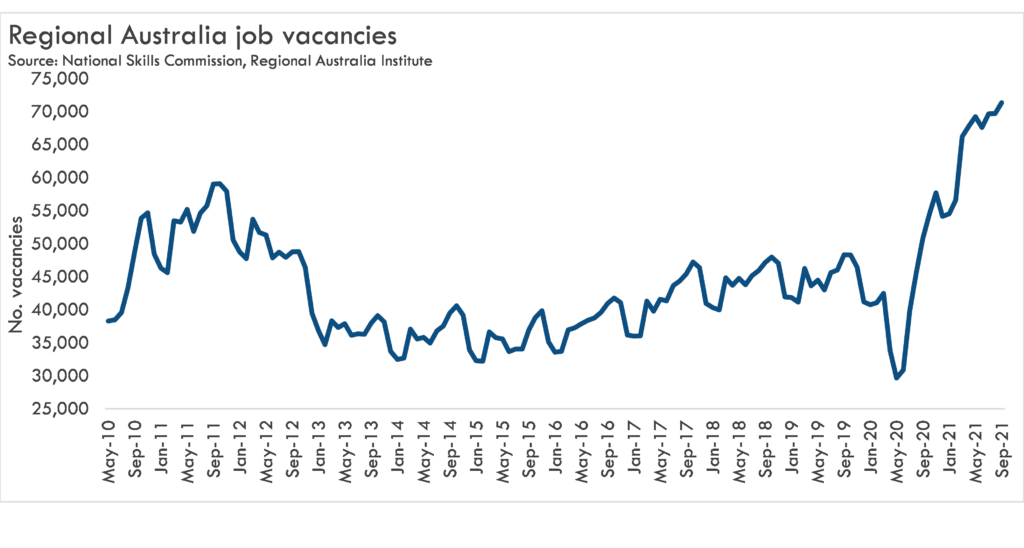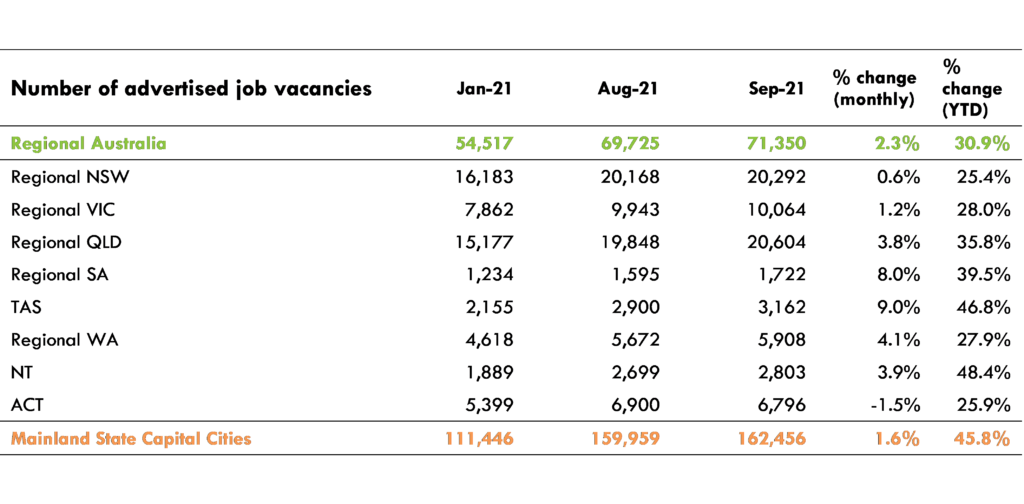Regional job vacancies set yet another record in the month of September 2021. Following August’s new high of 69,800, vacancies increased again in September to reach more than 71,300 advertised jobs. Labour shortages are now holding back economic recovery in most of regional Australia as vacancies are growing faster than inflows of workers.
Topping 70,000 vacancies for the first time in September coincided with the Regional Australia Institute marking its 10th anniversary. In September 2011, when the Institute was established, job vacancies were also at record levels, at just under 60,000 vacancies. It was the height of the mining construction boom, and the mix of job ads reflected the country’s then two-speed economy – vacancies were narrowly based across the resources sectors and states (mainly Queensland, Western Australia and the Northern Territory). Total job vacancies in regional New South Wales and Victoria were at best holding steady during that time.
This month, regional Queensland and Western Australia both topped their 2011 mining boom vacancy records, while regional New South Wales, Victoria, South Australia and Tasmania collectively showed 50% more vacancies than a decade ago. The Northern Territory continues to show steady growth.
The effect of the lockdowns on business confidence is very clear, with the biggest monthly growth from August to September 2021 being in the regional areas of the COVID-free states Tasmania (9.0%), South Australia (8.0%), Western Australia (4.1%) and Queensland (3.8%). Vacancy growth over the month in regional Victoria was just 1.2% and in regional New South Wales was just 0.6%.
The rate of vacancy growth in regional New South Wales and Victoria has fallen in the last few months, moderating the very strong growth earlier in the year and pulling year-to-date growth down to rates below the other states. There is also more variation across these two states than the regional areas of the COVID-free states. In regional NSW vacancy growth in Gosford & Central Coast is still weak at just 7% through 2021, while Dubbo & Western NSW still struggles to find workers with growth of 45% through 2021. In regional Victoria too, vacancy growth ranges from 21% over 2021 in Bendigo & High Country and Gippsland, through to 38% in Geelong & Surf Coast.
In marked contrast, labour markets in the regions in the COVID-free states continue to tighten with vacancy growth of at least 30% through 2021 in all regions, except for Pilbara & Kimberley at 22%. The highest rates of vacancy growth through 2021 (44-56%) are in Darwin, Tasmania, Western New South Wales and Southwest Queensland.

The five regions with the biggest jumps in vacancies between August and September 2021 were:
- Launceston and Northeast Tasmania with 11% more vacancies in September 2021 (809) than in August 2021 (731)
- Fleurieu Peninsula & Murray Mallee in SA up by 10% (894 compared to 816)
- Hobart and Southeast Tasmania up by 9% (1,810 compared to 1,661)
- Yorke Peninsula & Clare Valley in SA up by 8% (255 compared with 237)
- North West Tasmania up by 7% (543 compared with 508)
The five regions with the biggest jumps in vacancies in the year to date through 2021are:
- Darwin up by 56%
- Hobart and Southeast Tasmania up by 52%
- Launceston and Northeast Tasmania up by 48%
- Dubbo and Western NSW up by 45%
- Toowoomba & South West Queensland up by 44%

The ongoing high rates of vacancy growth across regional Australia are pointing to ever–tightening labour markets and intensifying recruitment difficulties. Nationally, the disruption caused by the pandemic saw falls in vacancies for lower-skilled jobs, a trend which is starting to reverse, though the total level of employment in lower–skilled jobs is still below where it was before the pandemic.
In regional Australia the occupations in greatest demand are Professionals (27% of advertised vacancies), Technicians & Trades Workers (15%) and Clerical & Administrative Workers (13%). These are generally well-paid positions, and with the lower cost of housing and great lifestyle options in regional Australia they should be attractive positions.
But Australia’s labour markets are not as mobile as they should be, and population growth does not track well with job demand. Workers are not yet moving to where the jobs are. There are many regions where jobs growth significantly outpaces population growth. One is Riverina & Murray which has seen over 65% growth in job vacancies over the decade to mid 2020, but just 5% population growth over the same period. Dubbo & Western NSW saw 3% vacancy growth over the same period, but a 1% decline in population.
Up-to-date information on people movements is revealed in the RAI-CBA Regional Movers Index. The Index shows historically high levels of net migration from cities to regions in Australia this year. But this is due largely to more regional people staying in regions and reduced flows from regions to cities, than it is due to city people moving to take up these regional job opportunities. The pandemic is clearly interfering with these usual flows, particularly when there are statewide lockdowns. The combination of surging city house prices and growing high skill vacancies should see a lift in the number of people relocating to regional Australia in coming months, and we will be watching the Regional Movers Index closely for signs of this. The RAI’s Move To More campaign is seeking to influence these relocations, for the benefit of both future regional workers and existing regional employers.
To build the post–pandemic recovery, it is in the nation’s interest that regional employers who are willing and able to grow become more confident that they’ll be able to find the skilled workers that they need. A lift in relocations to regions, and a boost to post-school learning opportunities in regions to help skill up the local workforce, are two critical priorities in meeting regional skills needs in coming months.